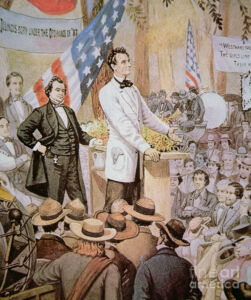And Now, The WHY: An Educated Guess
by Karl Denninger, Market Ticker:

Boeing is now running what I consider to be a steaming pile of  — that “none of this is really about safety.” Like all good progressive companies (that’d be all of them where diversity trumps merit these days and yes, Boeing has explicitly said this — look at their own page) telling half the truth comes with that claptrap.
— that “none of this is really about safety.” Like all good progressive companies (that’d be all of them where diversity trumps merit these days and yes, Boeing has explicitly said this — look at their own page) telling half the truth comes with that claptrap.
Specifically, it would be idiotic in the extreme to deliberately ignore safety and nobody is really suggesting that or has. However, putting corporate shenanigans for “diversity” and “shareholder value” first, ahead of everything else (especially the latter) is another thing entirely.
So let’s ask the question: Why would Boeing not update the MCAS trim authority spec from 0.6 degrees to the 2.5 degrees it actually needed when that was discovered during flight testing?
Well, the obvious reason was that it would force a re-evaluation of the risks of a failure in that system and that might force additional changes, all of which cost money. For example, it might have required a different certification (more cost for the airlines — that is, the customers — in pilot training), it might have required additional sensors and redundancy (more cost for Boeing.) The latter is a certainly; it would have prohibited, for example, charging some unknown (but likely ungodly large) amount of money to have a warning light turn on if the two sensors disagree. (It has already been developed that the aircraft knew the two sensors disagreed and willingly suppressed that information as the “option” wasn’t paid for because otherwise how could that fact be in the data?) In other words we already know factually that Boeing put money in front of safety and that intentional suppression of critical safety-related information from the pilots, standing alone, ought to be enough for criminal charges.
But what if there’s another problem that updating that spec would cause — a really, really awful one from a standpoint of “shareholder value”?
What if honest reporting and re-runs of the calculations it forced it would have set off a chain of events that would make the aircraft unmarketable, or at least compromised the marketability .vs. their competitors (e.g. Airbus)?
The “Nex Gen”, which was the previous 737 series, has a length from 110′ 4″ to 138′ 2″ depending on the specific model (700-900) and was powered by a less-efficient engine that didn’t have the nasty pitch-up problem. But even in the basically identical-length versions — the Next Gen 800 to the Max-8 — the Max typically carries more people, that is, more load (up to 172 seats in the 2-class version which is 16 more than the 162 configuration of the 737-800.)
One of the basics of aircraft stability is where the CG (Center of Gravity) lies. Pilots are required to perform weight and balance computations before flight. There’s a “decent guess” for people (they don’t actually make you get on a scale, but it’s sorta obvious, right?) and they do weigh the cargo. Many aircraft carry a fair bit of commercial cargo in the hold beyond the passengers checked baggage and they make a decent amount of money doing it too; empty space on a plane that is already going somewhere makes no money and it doesn’t cost much more in fuel to put more cargo in the aircraft (that is, a large percentage of the fuel consumed moves the airplane irrespective of how much “stuff” is inside and the crew on board get paid the same irrespective of whether the plane is full or empty.) There’s a “consumer version” of this “air cargo” service that carriers offer and it’s very profitable for them too; Delta Dash is Delta’s name for it in the States. When you absolutely, positively, have to get something from Chicago to Atlanta in a few hours and don’t give a damn about how expensive making that happen is…..
One really good way to get killed in an aircraft of any size is to put the CG outside of the safe zone; do that and under some flight conditions the airplane cannot be controlled, and one of the places that lack of control tends to show up first is when the plane is traveling at lower speeds — you know, like when taking off and landing!
The elevator has only a certain amount of authority; being able to set the “center” point (that is, where the plane flies level) with the control yoke centered means you have full authority as a pilot in BOTH the up and down directions. Exactly where that trim has to go to do that depends on many things and shifts during flight — but one of the things that controls where that neutral point occurs happens to be where the CG is on the plane.
If the MCAS requires 0.5 degrees of downward trim out of 5 degrees from neutral if it is called upon to stabilize the aircraft, such as when power is added with a high AOA and low airspeed, then it requires about 12% of the stabilizer trim range in the downward direction.
Again, if the MCAS is actually required to safely fly the aircraft because under certain conditions (like adding power in a high AOA, low-speed flight state near the ground where you cannot trade altitude for airspeed) the aircraft will otherwise not be aerodynamically stable (e.g. will crash) then that trim range must be locked out from manual pilot selection so MCAS remains able to use it.
What we now know from the report in the paper, however, is that during testing the maximum authority was raised to 2.5 degrees out of 5.0 total travel from neutral, an increase of 400%. It is quite safe to assume that increase wasn’t arbitrary and flight testing disclosed that this much larger range was necessary for stability.
This means the pilot must be prohibited from using that 2.5 degrees himself; it has to be reserved. Otherwise if the pilot has manually trimmed to (say) 4 degrees down and MCAS wants 2.5 more there’s only 1 remaining; the computer hits the physical end of the jackscrew and that’s the end of it. If the 2.5 is really required at that point to prevent a stall when power is added — the only option available if you have no altitude to trade with — and the aircraft is near the ground the result is likely a crash and loss of the hull along with some or all of the people on board.
The base issue that MCAS was put on the plane to address is, as I and others have noted, to deal with the changes in flight characteristic that came from fitting the larger engines, which required they be moved forward and upward a bit. Moving them upward, all things being equal, would move the centerline of thrust up (toward the CG vertically) which would reduce the amount of “nose lift” moment from applying thrust. This was likely canceled, however, by their larger size (which moves the centerline down.) But moving them forward adds moment compared to where the CG is on the aircraft fore/aft. This Boeing should have been able to accurately model. But it appears where they screwed the pooch is that the materially higher amount of bypass (that is, the amount of air the fan blows out the back of the engine to get thrust and the percentage of the total thrust of the engine that comes from that) causes much more nose lift moment than their models suggested, especially when the engines were operating at a high power level — thus the designed 0.6% nose-down trim wasn’t enough for MCAS and they raised it to 2.5% during flight testing.
This means, again, that for the system to do its job the pilot can’t use that 2.5 degrees or the MCAS system will be unable to use it because there’s not that much left. It’s unclear whether Boeing, when they changed the MCAS limit of authority, prohibited the pilot from manually invading that same space but what is clear is that you can’t use the same thing twice and if they had re-run the analysis someone’s finger would have gone up in the air and pointed this out, forcing everyone go back through and evaluate whether the 2.5 degrees was really necessary and, if it is, then the pilot can’t have it at his or her discretion and thus the discretionary amount of trim available would have to be changed.
What’s the impact of constraining the trim range?
Among other things it likely flows through to the safe CG range, forcing a re-computation of the plane’s load limits and load distribution.
Like, for instance, load in all those new seats and in the bays above and cargo space below, especially in the rear of the aircraft.
And that, ultimately, determines how much revenue the plane can generate.
Fixing that, if the results were not what Boeing expected, would be very expensive as it would involve changes to where heavy things are located in the plane and quite possibly significant changes to the flight surfaces (e.g. wings, stabilizer, etc.)
Not fixing it might well mean the aircraft cannot carry the amount of people and cargo that both Boeing and Boeing’s customers expected and that could make the aircraft significantly less-competitive (in other words Boeing loses business to Airbus — maybe a lot of business.)
Folks, I know there are some out there who are way smarter than I am.
Loading...



